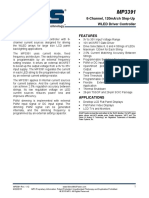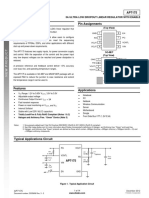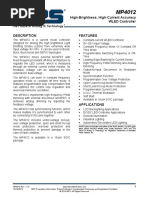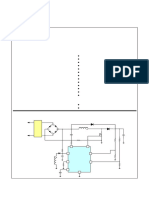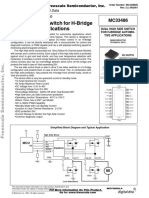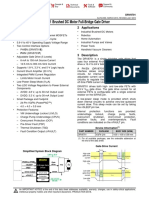MP1006
MP1006
Uploaded by
luis perdigonCopyright:
Available Formats
MP1006
MP1006
Uploaded by
luis perdigonCopyright
Available Formats
Share this document
Did you find this document useful?
Is this content inappropriate?
Copyright:
Available Formats
MP1006
MP1006
Uploaded by
luis perdigonCopyright:
Available Formats
MP1006
OFF LINE CCFL/EEFL CONTROLLER
The Future of Analog IC Technology
MPS CONFIDENTIAL AND PROPRIETARY INFORMATION –TCL USE ONLY
DESCRIPTION FEATURES
The MP1006 is a high performance off-line • 9V Enhanced Gate Driver, Can Directly Drive
CCFL/EEFL controller designed for powering the the Gate Driving Transformer
Cold Cathode Fluorescent Lamp (CCFL) and • Programmable Fixed Operating Frequency
External Electrode Fluorescent Lamp (EEFL), • Input Voltage Range from 9V to 30V
especially for multi-lamp Liquid Crystal Display • Lamp Current and Voltage Regulation
(LCD) backlighting applications. • Burst Mode Dimming Control
The MP1006 utilizes fixed operating frequency • Integrated Burst Mode Oscillator and Modulator
PWM control to the inverter. It outputs two 180 • Soft-On and Soft-Off Burst Envelope
degree phase shifted driving signals for various • Smart Fault Protection Interface
external power stages. Its enhanced 9V gate • Built-in fault management
driver provides adequate driving capability for • Dual Mode Fault Timer
the external MOSFETs. It is able to directly • Programmable Striking Frequency, Striking
drive the external gate driving transformer. The Time and Burst Dimming Frequency
inverter converts unregulated DC voltage to a • Unique Short Circuit Current Limitation
nearly sinusoidal lamp voltage to power up • Available in SOIC 16 Package
CCFL or EEFL lamps.
The MP1006 implements burst mode dimming
APPLICATIONS
to the lamp. Burst mode dimming is controlled • LCD TV and LCD Monitor in Off-line System
with either an external DC voltage or PWM • Flat Panel Video Displays
signal. • Off Line Inverter for CCFL/EEFL driver
The Built-in fault management features include “MPS” and “The Future of Analog IC Technology” are Registered Trademarks of
Monolithic Power Systems, Inc.
open lamp regulation and protection, short circuit
R
The MP1006 is covered by US Patents 6,683,422, 6,316,881, and
protection and over temperature protection. The 6,114,814. Other Patents Pending.
protection interface is flexible for various setups
E
and is easy to use.
The MP1006 is available in a 16-pin SOIC
E
package.
MP1006 Rev.0.9 www.MonolithicPower.com 1
11/27/2008 MPS Proprietary Information. Unauthorized Photocopy and Duplication Prohibited.
© 2009 MPS. All Rights Reserved.
MP1006—OFF LINE CCFL/EEFL CONTROLLER
MPS CONFIDENTIAL AND PROPRIETARY INFORMATION –TCL USE ONLY
SIMPLIFIED TYPICAL APPLICATION
400V LV1
LI1
MP1006
1 16
OLP OLP GR
2 15
LV LV GND LI2
LV2
3 14
VDRV SLP GL
VDRV
LV3
4 13
LI LI VDRV
LI3
5 12
COMP VIN
11
Y
6
FT EN
7 10
LCC DBRT
L
9 400V GND
8
LCS BOSC
LV4
N
LI4
O
DBRT
LV1
EN LV LV2
LV3
E
VIN
LV4
S
LV1
LI1 LV4
OLP
U
LI LI2
400V LV2
LI3
LV3
400V GND LI4
MP1006 Rev.0.9 www.MonolithicPower.com 2
11/27/2008 MPS Proprietary Information. Unauthorized Photocopy and Duplication Prohibited.
© 2009 MPS. All Rights Reserved.
MP1006—OFF LINE CCFL/EEFL CONTROLLER
MPS CONFIDENTIAL AND PROPRIETARY INFORMATION –TCL USE ONLY
PACKAGE REFERENCE ABSOLUTE MAXIMUM RATINGS (1)
Input Voltage VIN .......................................... 35V
GL, GR ........................................ -0.3V to 10.7V
Logic Inputs, LV, OLP ................. –0.3V to +6.5V
LI, SLP ........................................ –5.8V to +5.8V
Junction Temperature .............................. 150°C
Lead Temperature (Solder)...................... 260°C
Operating Frequency .............................150KHz
Storage Temperature .............. –55°C to +150°C
(2)
Recommended Operating Conditions
Input Voltage VIN .................................9V to 30V
Y
Operating Frequency ............. 20KHz to 100KHz
Operating Frequency (Typical) ................50KHz
L
Operating Temperature............ –20°C to + 85°C
N
Part Number* Package (3)
Thermal Resistance θJA θJC
MP1006ES SOIC16 SOIC16 ...................................80 ...... 30 ... °C/W
O
Temperature Top Marking
Notes:
–20°C to +85°C MP1006ES 1) Exceeding these ratings may damage the device.
2) The device is not guaranteed to function outside of its
* For Tape & Reel, add suffix –Z (eg. MP1006ES–Z)
E
operating conditions.
For RoHS Compliant Packaging, add suffix –LF (eg. 3) Measured on JESD51-7, 4-layer PCB
MP1006ES–LF–Z)
S
U
ELECTRICAL CHARACTERISTICS
VIN = 12V, TA = +25°C, unless otherwise noted.
Parameter Symbol Condition Min Typ Max Units
Gate driver GL, GR
Gate Pull-Down RGD 2 Ω
Gate Pull-Up RGU 4 Ω
Output Source Current ISOURCE 1 A
Output Sink Current ISINK 2 A
Maximum Duty Cycle DMAX 46%
EN
EN Turn On Threshold VEN-ON 2 V
EN Turn Off Threshold VEN-OFF 1 V
Internal Pull-down Resistor REN-IN 60 kΩ
Brightness Control Range
DBRT Full Scale VDBRT DC burst dimming 1.1 1.2 1.3 V
DBRT Logic Input Threshold VTH-DBRT PWM dimming 1.6 1.9 2.2 V
DBRT Logic Input Hysteresis VTH-DBRT-Hyst PWM dimming 0.3 V
Burst Rate Generator
Source Current ISRC(BRS) VBRS = 2V 120 150 180 µA
Lower Threshold VV(BRS) 2.2 2.4 2.6 V
Upper Threshold VP(BRS) 3.3 3.55 3.8 V
MP1006 Rev.0.9 www.MonolithicPower.com 3
11/27/2008 MPS Proprietary Information. Unauthorized Photocopy and Duplication Prohibited.
© 2009 MPS. All Rights Reserved.
MP1006—OFF LINE CCFL/EEFL CONTROLLER
MPS CONFIDENTIAL AND PROPRIETARY INFORMATION –TCL USE ONLY
ELECTRICAL CHARACTERISTICS (continued)
VIN = 12V, TA = +25°C, unless otherwise noted.
Parameter Symbol Condition Min Typ Max Units
Supply Current
Supply Current (Enabled) IIN-EN No driver output 1.5 2.5 mA
Supply Current (Disabled) IIN-OFF VIN=30V 1 µA
Operating Frequency fO 25kΩ LCS to GND 46 50 54 kHz
Frequency Set Voltage VLCS 1.1 1.2 1.3 V
Lamp Clock Control (LCC)
Start Sweeping
LCC Enable Threshold VLCC-EN 0.8 0.9 1.0 V
Y
Frequency
At Fault Condition,
L
LCC Source Current ILCC-FT 44 48 51 µA
25kΩ LCS to GND
Frequency Increase Slope ∆F0/∆VLCC 0.9V<VLCC<4.9V 14 15.5 17 kHz/V
N
Lamp Current Feedback (LI)
Magnitude |VLI| 1.13 1.20 1.27 V
O
Sine Equivalent VLI 1.33 Vrms
Input resistance RLI_IN 60 kΩ
E
Lamp Voltage Feedbacks (LV)
Open Lamp Voltage
VTH(LV) 2.2 2.4 2.6 V
S
Feedback Threshold (Peak)
Fault Timer
U
Threshold Vt(FT) 2.2 2.4 2.6 V
Sink Current ISINK(FT) –1 µA
Open Lamp Source Current IPU_OL(FT) 1 µA
Short Lamp Source Current IPU_SL(FT) 100 µA
Comp
Clamp Voltage VCOMP 0.60 V
Reference Current ICOMP+ 20 µA
Reference Current at Fault µA
ICOMP+FT Fault Condition 3.7
Condition
Pull Down Current at Voltage µA
ICOMP-VR LV>2.4V 30
Regulation
Decay Current ICOMP- End of Burst 12 µA
Fault Detection Threshold (OLP, SLP, LI)
OLP Threshold VOLP 2.2 2.4 2.6 V
SLP Threshold VSLP 2.2 2.4 2.6 V
SLP Detection Delay Time TSLP Start when VCOMP>0.9V 400 us
LI threshold VLI 0.55 0.60 0.65 V
LI Detection Delay Time TLI Start when VCOMP>0.9V 400 us
Output Gate Driver (VDRV)
Voltage VVDRV No load 8.7 9.7 10.4 V
Current IVDRV 20 mA
MP1006 Rev.0.9 www.MonolithicPower.com 4
11/27/2008 MPS Proprietary Information. Unauthorized Photocopy and Duplication Prohibited.
© 2009 MPS. All Rights Reserved.
MP1006—OFF LINE CCFL/EEFL CONTROLLER
MPS CONFIDENTIAL AND PROPRIETARY INFORMATION –TCL USE ONLY
PIN FUNCTIONS
Pin # Name Description
1 OLP Open Lamp Protection Input. A comparator is integrated in this pin for open lamp protection.
If the voltage on this pin gets higher than 2.4V, the open lamp protection will be generated. It
starts the fault timer by sourcing a 1uA current from FT pin, sweeps up the operating
frequency by generating an internal current source flowing out of LCC pin, and disables the
burst dimming.
2 LV Lamp Voltage Feedback Input. The lamp voltage is sensed by this pin through a voltage
divider from the hot end of the lamp to ground. If the voltage at LV exceeds +2.4 V, the
COMP pin voltage is regulated to keep the lamp voltage at a high constant value. At the
same time, the fault protection is triggered and the fault timer is started. The burst dimming is
disabled when fault protection is triggered.
3 SLP Short Lamp Protection Input. A comparator is integrated in this pin for short lamp protection.
Y
If the voltage on this pin gets lower than 2.4V for 400us (counting when VCOMP>0.9V), the
short protection will be generated. It starts the fault timer by sourcing a 100uA current from
FT pin, sweeps up the operating frequency by generating an internal current source flowing
L
out of LCC pin, and disables the burst dimming. The reference for the lamp current feedback
is lowered down to 1/6 in order to limit the short current. The protection function is disabled at
N
burst off interval.
4 LI Lamp Current Feedback Input. Connect this pin to the cold end of the lamp and shunt a
O
sense resistor to ground. The internal error amplifier will sink a current from the COMP pin
proportional to the absolute value of the voltage at this pin. The average of the absolute value
of the voltage at this pin is regulated to 1.2V reference voltage.
The voltage on this pin is also used for open lamp detection and protection. When the voltage
E
on this pin gets lower than 0.6V for 400us (counting when VCOMP>0.9V), the IC recognize this
as open lamp condition and generate a signal to sweep up the operating frequency and
S
disable the burst dimming. At the same time, the fault protection is triggered and fault timer is
started. At burst off interval, the detection and protection are disabled.
U
5 COMP Feedback Compensation Node. Connect a compensation capacitor from this pin to GND.
6 FT Fault Timer. Connect a timing capacitor from this pin to GND to set the fault timeout period.
When the voltage on this pin gets higher than the 2.4V threshold, the IC latches up until EN is
toggled.
7 LCC Lamp Clock Control. The voltage on LCC will control the switching frequency. Connect a
resistor paralleled with a capacitor from this pin to GND. If open lamp or short circuit is
detected, an internal current will source from this pin. The sourcing current is determined by
the LCS pin resistor. The voltage on this pin from 0.9V to 4.9V will linearly increase the
operating frequency by 0 to 61kHz. LCC pin is also a flag that the fault condition is triggered.
8 LCS Lamp Clock Set. Connect a resistor from this pin to GND. This resistor sets the operating
frequency of the MP1006. A 25kOhm resistor sets the operating frequency at typical 50kHz.
9 BOSC Burst Repetition Set. Connect a resistor in parallel with a capacitor from BOSC to GND. The
resistor and capacitor programs the burst repetition rate and the minimum burst duty cycle. If
the burst dimming is to be controlled by an external logic signal, pull up BOSC to VDRV
through a 20kΩ resistor and apply the logic signal to the DBRT pin.
10 DBRT Burst-Mode (Digital) Brightness Control Input. The voltage range from 0 V to 1.2V at DBRT
linearly sets the burst-mode duty cycle from the minimum duty to 100%. For external PWM
input dimming, directly apply the logic signal on this pin. The MP1006 has positive dimming
polarity.
11 EN Enable Input. Pull EN high to turn on the chip, and pull EN low to turn it off.
MP1006 Rev.0.9 www.MonolithicPower.com 5
11/27/2008 MPS Proprietary Information. Unauthorized Photocopy and Duplication Prohibited.
© 2009 MPS. All Rights Reserved.
MP1006—OFF LINE CCFL/EEFL CONTROLLER
MPS CONFIDENTIAL AND PROPRIETARY INFORMATION –TCL USE ONLY
PIN FUNCTIONS (continued)
Pin # Name Description
12 VIN Supply voltage input.
13 VDRV Linear Regulator Output and Bias Supply of the Gate Driver. It provides the supply for the
gate driver and also the external control circuit, the typical value is 9.7V. Bypass VDRV with a
1μF or larger ceramic capacitor.
14 GL Driving signal output, 180 degree phase shifted of GR
15 GND Ground.
16 GR Driving signal output, 180 degree phase shifted of GL
Y
OPERATION
L
6 FT
N
1 OLP
2.4V VDRV
O
3 SLP
2.4V Fault
Management GL 14
2 C
E
LV Gate
2.4V O Driver
N
S
0.6V
4 T
LI
R
U
O
Error L
1.2V Amplifier VDRV
0.2V at short L
Lamp
5 COMP
PWM O
G 16
GR
8 LCS I Gate
Lamp Driver
7 Clock
C
LCC 15
GND
9 BOSC
Burst
Rate
Generater
10 DBRT VIN 12 VIN
Regulator
11 EN
VDRV 13
Figure 1—MP1006 Block Diagram
MP1006 Rev.0.9 www.MonolithicPower.com 6
11/27/2008 MPS Proprietary Information. Unauthorized Photocopy and Duplication Prohibited.
© 2009 MPS. All Rights Reserved.
MP1006—OFF LINE CCFL/EEFL CONTROLLER
MPS CONFIDENTIAL AND PROPRIETARY INFORMATION –TCL USE ONLY
DESIGN INFORMATION duty cycle. When burst dimming with external
PWM signal, pull up BOSC pin to VDRV through
Steady State and Enable Control
a 20kΩ resistor and apply the PWM signal on
The MP1006 is a fixed operating frequency off- DBRT pin.
line inverter controller specifically designed for
Fault Protection
the backlighting of multiple lamp liquid crystal
displays (LCD). Powered by 9V to 30V input System fault management facilities include the
supplies, the MP1006 outputs two 180 degree on-chip open-lamp detector and regulator, a dual
phase shifted driving signals for the external mode fault timer and two smart comparators for
power stages. Its enhanced 9V gate driver open lamp and short circuit protection.
provides adequate driving capability to the
The lamp voltage is monitored by the LV pin
external MOSFETs. It is able to directly drive the
through a capacitor divider, once the voltage on
external gate driving transformer.
LV pin exceed 2.4V reference, the MP1006 will
The operating frequency is set by an external pull down the COMP voltage by a current pulse
Y
resistor to minimize the possibility of interference and reduce the power delivering to the power
with the refresh rate of the display. The operating stage. Thus smoothly and stably regulate the
L
frequency can be set by the resistor connected lamp voltage to a user programmed striking
from LCS pin to GND. voltage. At the same time when LV pin voltage
N
hits the 2.4V threshold, the Open Lamp Mode is
The lamp striking frequency under open lamp
triggered.
condition is programmed by the LCC pin. The
O
voltage on LCC in range of 0.9~4.9V linearly At Open Lamp Mode, the IC generates an
increases the operating frequency by 0 to 61kHz. internal current source flowing out of the LCC pin.
When LCC voltage is lower than 0.9V, the Together with the resistor connected from LCC to
E
operating frequency is not influenced. GND, a user programmed voltage is generated,
which linearly increases the operating frequency.
S
The MP1006 utilizes PWM control to the inverter.
The LCC pin voltage in range of 0.9~4.9V linearly
The lamp current is sensed at LI pin and compared
programs the frequency increase by 0 to 61kHz.
with internal reference. The internal error amplifier
U
The LCC pin internal current source is
generates the error signal on COMP pin to control
determined by the LCS pin resistor. And the
the PWM duty cycle. The full-wave lamp current
capacitor on LCC pin helps to program the
sense amplifier provides superior output pulse
frequency sweeping speed. Meanwhile, a 1uA
symmetry and loop response time.
current source will charge the FT cap. If the
The system power is controlled by EN pin. When voltage on FT pin exceeds 2.4V, the controller
the chip is enabled, the built-in regulator for VDRV will shutdown and latch until the EN pin is toggled
is powered up and the internal circuit starts. to restart the IC. Choose a proper capacitor on
FT pin to obtain a desired timeout. In normal
Brightness Control
condition a 1μA sink current keeps the FT pin at
MP1006 implements burst dimming (digital 0V. During Open Lamp Mode, the IC ignores the
brightness) of the lamp. Burst mode operation burst control and runs continuously to ensure
dims the lamp by modulating the duty cycle of a either the lamp has a chance to re-ignite or the
burst of AC lamp current and features soft- fault timer can smoothly and accurately time out.
on/soft-off control of the lamp current envelope.
The MP1006 has a built-in burst oscillator which The lamp current feedback LI pin also functions
can generate a triangle waveform on the BOSC as the open lamp detection. If the peak voltage
pin. Burst dimming can be achieved by either a on LI pin is lower than 0.6V for 400us (count
DC voltage input or external PWM signal. When when VCOMP>0.9V), the IC recognizes the lamp is
burst dimming with a DC input voltage, add a open, and triggers the Open Lamp Mode. At
capacitor in parallel with a resistor on BOSC pin burst dimming off interval, the fault detection on
to set the burst frequency and apply the DC LI pin is disabled.
voltage on the DBRT pin to program the burst
MP1006 Rev.0.9 www.MonolithicPower.com 7
11/27/2008 MPS Proprietary Information. Unauthorized Photocopy and Duplication Prohibited.
© 2009 MPS. All Rights Reserved.
MP1006—OFF LINE CCFL/EEFL CONTROLLER
MPS CONFIDENTIAL AND PROPRIETARY INFORMATION –TCL USE ONLY
Two smart comparators are integrated for the
open lamp and short circuit protection. It
simplifies the protection design in multiple lamps
application.
The OLP pin is used for open lamp protection.
When the voltage on OLP pin is higher than 2.4V,
the IC recognizes this as open lamp condition
and triggers the Open Lamp Mode.
The SLP pin is used for short lamp protection.
When the voltage on SLP pin is lower than 2.4V
for 400us (count when VCOMP>0.9V), the IC
recognizes it as short lamp condition and triggers
Y
the Short Lamp Mode. At burst dimming off
L
interval, the fault detection on SLP pin is disabled.
At Short Lamp Mode, the IC also charges up the
N
LCC pin to sweep up the frequency and ignores
the burst dimming. It starts the short mode fault
timer by sourcing a 100uA current to charge the
O
FT capacitor, which is 100 times faster than that
in the Open Lamp Mode. During Short Lamp
Mode, the internal current feedback reference is
E
reduced to 1/6 of the normal value, which helps
for limiting the short circuit current to meet the
S
safety requirement.
MP1006 Rev.0.9 www.MonolithicPower.com 8
11/27/2008 MPS Proprietary Information. Unauthorized Photocopy and Duplication Prohibited.
© 2009 MPS. All Rights Reserved.
MP1006—OFF LINE CCFL/EEFL CONTROLLER
MPS CONFIDENTIAL AND PROPRIETARY INFORMATION –TCL USE ONLY
APPLICATION INFORMATION Pin 5 (COMP):
Pin 1 (OLP): This pin is used for compensation. Connect a
1~4.7nF capacitor from COMP to GND. This cap
Open Lamp Protection: This pin is used for open should be X7R ceramic. The value of this cap
lamp protection, when the voltage on this pin is determines the stability of the lamp current
higher than 2.4V, the IC recognize this as open regulation and open lamp voltage regulation. It
lamp condition and triggers Open Lamp Mode. also affects the soft-on rise time and soft-off fall
Connect the signals which can indicate open time at burst dimming.
lamp condition to this pin. The maximum lamp
voltage, the maximum lamp voltage difference or Pin 6 (FT):
the maximum lamp current difference are usually Connect a capacitor from this pin to GND to set
used to indicate the open lamp condition. the fault timer.
Pin 2 (LV): Open Lamp Time Out:
Open Lamp Voltage Regulation: This pin is used t OPEN LAMP × 1μA
C1 =
for open lamp voltage regulation and open lamp 2.4V
Y
protection. When the voltage on this pin exceeds
2.4V, an internal current source will discharge For a C1 = 1uF, then the time out for open lamp
L
COMP to regulate the open lamp voltage. The will be 2.4 sec.
regulated open lamp voltage is proportional to Short lamp Timeout: When Short Lamp Mode is
N
the ratio of the voltage divider in the voltage triggered, the IC charges the FT cap with 100uA
feedback. When LV voltage hits 2.4V, the IC current. The short lamp timeout is about 1/100 of
recognizes this as open lamp condition and the open lamp timeout. To further reduce the
O
triggers Open Lamp Mode. short lamp timeout, modify the network at the FT
Pin 3 (SLP): pin as shown in Figure 2.
E
Short Lamp Protection: This pin is used for short FT
lamp protection, when the voltage on this pin
S
gets lower than 2.4V for 400us (Count when C2A C2B
VCOMP>0.9V), the IC takes it as short lamp
U
condition and triggers Short Lamp Mode. The
minimum lamp voltage is usually used to indicate
the short lamp condition. Figure 2—Timeout Adjustment
Pin 4 (LI): For C2B = 100nF, then the short lamp timeout is
as short as 2.4ms.
Lamp Current Regulation: This pin is used for
Current regulation. The lamp current is fed back Note: The open lamp time out will remain the
to the LI pin. The absolute voltage on this pin is same value as defined by C2A.
regulated with 1.2V average value. For the
Pin 8 (LCS):
sinusoid waveform on this pin, its RMS value is
regulated to 1.33Vrms. At Short Lamp Mode, the Connect a resistor from this pin to GND to set
reference voltage for LI is reduced to 0.2V (1/6) the lamp operating frequency (fo). The value for
to limit the short circuit current. this resistor R1 is calculated by
LI pin also functions as open lamp detection, 1.25 × 10 9
when the voltage on this pin gets lower than 0.6V R1 =
for 400us (count when VCOMP>0.9V), the IC fo
recognizes this as open lamp condition and For R1 = 25kΩ, operating clock will be 50kHz.
triggers Open Lamp Mode.
MP1006 Rev.0.9 www.MonolithicPower.com 9
11/27/2008 MPS Proprietary Information. Unauthorized Photocopy and Duplication Prohibited.
© 2009 MPS. All Rights Reserved.
MP1006—OFF LINE CCFL/EEFL CONTROLLER
MPS CONFIDENTIAL AND PROPRIETARY INFORMATION –TCL USE ONLY
Pin 7 (LCC): PWM signal. Logic High is Burst On and a logic
Low is Burst Off.
This pin is used to program the striking frequency
at open lamp condition. The voltage on this pin in Pin 9 (BOSC):
range of 0.9V~4.9V increases the operating
BOSC pin is used to set the burst dimming
frequency by 0~61 kHz, as shown in figure 3.
frequency. Connect a resistor (R2) in parallel with
a capacitor (C3) on this pin to set the burst
dimming frequency and the minimum burst on
time: tMIN, as shown in figure 4.
Y
Figure 3—Striking Frequency vs. LCC Voltage
L
At Open Lamp Mode or Short Lamp Mode, an
internal current source flows out of this pin. With
N
a resistor in parallel with a capacitor on this pin,
the IC softly sweeps up the striking frequency.
O
The resistor determines the striking frequency
value and the capacitor determines the sweeping
speed. It helps to establish the striking voltage to Figure 4—Burst Mode with DC Input Voltage
E
ignite the lamp and also helps to eliminate the at DBRT Pin
voltage spike by its soft sweeping.
Set tMIN to achieve the minimum required system
S
The LCC voltage is:
brightness. Ensure that tMIN is long enough that
1.2V the lamp does not extinguish.
V LCC = × RLCC
U
RLCS
These values are determined as follows:
The striking frequency is:
Fstrike = Fop + (VLCC − 0.9) × 15.5 × 10 3 Select a Minimum Duty Cycle, DMIN, where:
The sweeping frequency can also be D MIN = t MIN × fBurst
programmed externally by applying a voltage to R2 and C3 are determined by:
LCC pin. At this condition, connect a 100Ω
resistor on LCC pin to limit the flowing out current. ⎛ 1 ⎞
R 2 ≈ 21.16k ⎜⎜ − 1⎟⎟ + 21.43k
Pin 10 (DBRT): ⎝ DMIN ⎠
This pin is used for burst brightness control. For
1 − DMIN
C3 =
DC input burst dimming, the DC voltage on this f Burst × R 2 × 0.405
pin controls the burst percentage on the output. For DMIN = 0.1, fBurst = 200Hz, then R2 = 212k, C3 =
The signal is filtered for optimal operation. A voltage 52nF
ranging from 0 to 1.2V on DBRT programs the For direct PWM burst dimming, pull BOSC high
burst dimming duty cycle from the minimum duty to VDRV through a 20kΩ resistor and apply the
cycle to 100%. PWM signal to DBRT pin.
For direct Pulse Width Modulation (PWM) burst
dimming, Pull BOSC high to VDRV through a
20kΩ resistor and connect DBRT to a logic level
MP1006 Rev.0.9 www.MonolithicPower.com 10
11/27/2008 MPS Proprietary Information. Unauthorized Photocopy and Duplication Prohibited.
© 2009 MPS. All Rights Reserved.
MP1006—OFF LINE CCFL/EEFL CONTROLLER
MPS CONFIDENTIAL AND PROPRIETARY INFORMATION –TCL USE ONLY
Pin 13 (VDRV):
Table 1—Function Mode
This pin provides the gate driver supply voltage,
Pin Connection
Function its typical value is 9.7V. Connect a 1uF or greater
DBRT BOSC ceramic capacitor on this pin to bypass the
Burst Mode with supply voltage. This voltage is also used to
0V to 1.2V C3, R2
DC Input Voltage supply the external control circuit.
To VDRV
Burst Mode with Pin 14(GL), Pin 16 (GR):
PWM through 20kΩ
External Source
resistor Gate driving signals output. GL and GR are 180
Burst Brightness Polarity: 100% duty cycle at degree phase shifted driving signals. With its
DBRT voltage 1.2V. enhanced driving capability, GL and GR are able
to directly drive the externally MOSFET in the off-
Pin 11 (EN): line system through a gate driving transformer.
Pull this pin high to enable the chip, and pull it Connect two 5Ω resistors in series with GL and
low to disable the chip. GR to eliminate the EMI noise injected to the IC.
Y
Pin 12 (VIN):
Supply voltage input. By pass the supply voltage
L
with a 0.1uF or greater ceramic cap. This cap
should be placed close to the IC.
N
O
S E
U
MP1006 Rev.0.9 www.MonolithicPower.com 11
11/27/2008 MPS Proprietary Information. Unauthorized Photocopy and Duplication Prohibited.
© 2009 MPS. All Rights Reserved.
LY
N
O
S E
U
MPS CONFIDENTIAL AND PROPRIETARY INFORMATION –TCL USE ONLY
P1006—OFF LINE CCFL/EEFL CONTROLLER
M
MP1006—OFF LINE CCFL/EEFL CONTROLLER
MPS CONFIDENTIAL AND PROPRIETARY INFORMATION –TCL USE ONLY
LY
N
O
S E
U
Figure 6—MP1006 400V EEFL Driver for 32” Panel
MP1006 Rev. 0.9 www.MonolithicPower.com 13
11/27/2008 MPS Proprietary Information. Unauthorized Photocopy and Duplication Prohibited.
© 2009 MPS. All Rights Reserved.
MP1006—OFF LINE CCFL/EEFL CONTROLLER
MPS CONFIDENTIAL AND PROPRIETARY INFORMATION –TCL USE ONLY
Y
PACKAGE INFORMATION
SOIC16
0.386( 9.80)
0.394(10.00) 0.024(0.61) 0.050(1.27)
16 9
0.063
(1.60)
0.150 0.228
(3.80) (5.80) 0.213
PIN 1 ID 0.157 0.244 (5.40)
(4.00) (6.20)
1 8
TOP VIEW RECOMMENDED LAND PATTERN
0.053(1.35)
0.069(1.75)
SEATING PLANE 0.0075(0.19)
0.0098(0.25)
0.013(0.33) 0.050(1.27) 0.004(0.10)
0.020(0.51) BSC 0.010(0.25) SEE DETAIL "A"
FRONT VIEW SIDE VIEW
NOTE:
0.010(0.25)
x 45o
0.020(0.50) 1) CONTROL DIMENSION IS IN INCHES. DIMENSION IN
BRACKET IS IN MILLIMETERS.
GAUGE PLANE 2) PACKAGE LENGTH DOES NOT INCLUDE MOLD FLASH,
0.010(0.25) BSC PROTRUSIONS OR GATE BURRS.
3) PACKAGE WIDTH DOES NOT INCLUDE INTERLEAD FLASH
OR PROTRUSIONS.
4) LEAD COPLANARITY (BOTTOM OF LEADS AFTER FORMING)
0.016(0.41) SHALL BE 0.004" INCHES MAX.
0o-8o 0.050(1.27) 5) DRAWING CONFORMS TO JEDEC MS-012, VARIATION AC.
6) DRAWING IS NOT TO SCALE.
DETAIL "A"
NOTICE: The information in this document is subject to change without notice. Users should warrant and guarantee that third
party Intellectual Property rights are not infringed upon when integrating MPS products into any application. MPS will not
assume any legal responsibility for any said applications.
MP1006 Rev. 0.9 www.MonolithicPower.com 14
11/27/2008 MPS Proprietary Information. Unauthorized Photocopy and Duplication Prohibited.
© 2009 MPS. All Rights Reserved.
You might also like
- Pub - Voltage Regulators For Next Generation Microproces PDFDocument421 pagesPub - Voltage Regulators For Next Generation Microproces PDFArtur ZaidullinNo ratings yet
- Nu-Pulse, Half-Bridge and Push-Pull CCFL Inverter ControllerDocument12 pagesNu-Pulse, Half-Bridge and Push-Pull CCFL Inverter ControllerRicardo PiovanoNo ratings yet
- General Description Features: 380Khz, 18V/2A Synchronous Step-Down DC-DC ConverterDocument19 pagesGeneral Description Features: 380Khz, 18V/2A Synchronous Step-Down DC-DC Converteroscar1162001No ratings yet
- Switching From The L6561 To The L6562: AN1757 Application NoteDocument9 pagesSwitching From The L6561 To The L6562: AN1757 Application Notedeilyn rivasNo ratings yet
- Halogen 12vDocument17 pagesHalogen 12veryNo ratings yet
- S Feature D Escriptio: LTC1163/LTC1165 Triple 1.8V To 6V High-Side MOSFET DriversDocument8 pagesS Feature D Escriptio: LTC1163/LTC1165 Triple 1.8V To 6V High-Side MOSFET DriversPablo LloveraNo ratings yet
- Transition-Mode PFC Controller With Fault Condition ProtectionDocument16 pagesTransition-Mode PFC Controller With Fault Condition ProtectionAdailton SantosNo ratings yet
- Transition-Mode PFC Controller With Fault Condition ProtectionDocument20 pagesTransition-Mode PFC Controller With Fault Condition ProtectionMega BoxNo ratings yet
- Design Consideration With AP3041: Application Note 1059Document6 pagesDesign Consideration With AP3041: Application Note 1059subisanNo ratings yet
- AL3066 DiodesDocument14 pagesAL3066 Diodesivan ivanovNo ratings yet
- Full Bridge CCFL Controller: The Future of Analog IC TechnologyDocument12 pagesFull Bridge CCFL Controller: The Future of Analog IC TechnologyRichu UhcirNo ratings yet
- Surge Stopping and Reverse Voltage Protection With The LM5069 PDFDocument7 pagesSurge Stopping and Reverse Voltage Protection With The LM5069 PDFĐỗ Văn ThủyNo ratings yet
- MP3391 r1.12Document18 pagesMP3391 r1.12Elsa Nababan EchaNo ratings yet
- MP3391Document18 pagesMP3391Raul AlfaroNo ratings yet
- Tle6250 v34 Can BusDocument28 pagesTle6250 v34 Can BusBer HonzaNo ratings yet
- Lm3280 Adjustable Step-Down DC-DC Converter and 3 Ldos For RF Power ManagementDocument26 pagesLm3280 Adjustable Step-Down DC-DC Converter and 3 Ldos For RF Power ManagementAdi PopaNo ratings yet
- Lm3280 Adjustable Step-Down DC-DC Converter and 3 Ldos For RF Power ManagementDocument27 pagesLm3280 Adjustable Step-Down DC-DC Converter and 3 Ldos For RF Power ManagementEliecer MenesesNo ratings yet
- 1310 FsDocument12 pages1310 FsMohamed HaddadNo ratings yet
- Flyback Controller Improves Cross Regulation For Multiple Output ApplicationsDocument2 pagesFlyback Controller Improves Cross Regulation For Multiple Output Applications邹昊芃No ratings yet
- Ds8204a 05Document19 pagesDs8204a 05marcelo Chiu LeonNo ratings yet
- Schema Electrica Convertor 2Vcc in 30VccDocument16 pagesSchema Electrica Convertor 2Vcc in 30VccDragos DragoshNo ratings yet
- Green-Mode PWM Controller With High-Voltage Start-Up CircuitDocument17 pagesGreen-Mode PWM Controller With High-Voltage Start-Up Circuitserrano.flia.coNo ratings yet
- Datasheet AP7175Document14 pagesDatasheet AP7175Edwin SorianoNo ratings yet
- Lps 5 eDocument8 pagesLps 5 eArifin IpinNo ratings yet
- Low Power Pulse Width Modulator: Description FeaturesDocument12 pagesLow Power Pulse Width Modulator: Description FeaturespatrykNo ratings yet
- MC145406 PDocument10 pagesMC145406 PpoindextNo ratings yet
- An1624 stsr3 Simplifies Implementation of Synchronous Rectifier in Flyback Converter StmicroelectronicsDocument22 pagesAn1624 stsr3 Simplifies Implementation of Synchronous Rectifier in Flyback Converter Stmicroelectronicsluuk.wNo ratings yet
- Features Descriptio: LT1080/LT1081 Advanced Low Power 5V RS232 Dual Driver/ReceiverDocument13 pagesFeatures Descriptio: LT1080/LT1081 Advanced Low Power 5V RS232 Dual Driver/ReceiverahmedNo ratings yet
- OB3372 On BrightDocument13 pagesOB3372 On BrightPedro Leandro SilvaNo ratings yet
- MPS MP1038 PDFDocument1 pageMPS MP1038 PDFAnas KaruniaNo ratings yet
- Descriptio Features: LT1505 Constant-Current/Voltage High Efficiency Battery ChargerDocument16 pagesDescriptio Features: LT1505 Constant-Current/Voltage High Efficiency Battery ChargerCarlos Henrique RibasNo ratings yet
- A4954 Datasheet PDFDocument9 pagesA4954 Datasheet PDFJason WuNo ratings yet
- Ap5004 Ap5004sg-13Document12 pagesAp5004 Ap5004sg-13carixo98No ratings yet
- 1154 FCDocument18 pages1154 FCZekeZer0xNo ratings yet
- Ucc 25701Document23 pagesUcc 25701hotelmogador.recNo ratings yet
- Advanced Voltage Mode Pulse Width Modulator: Description FeaturesDocument24 pagesAdvanced Voltage Mode Pulse Width Modulator: Description Featuresvanhuong87No ratings yet
- Complete DDR3/ DDR4 Memory Power Solution Controller: General Description FeaturesDocument15 pagesComplete DDR3/ DDR4 Memory Power Solution Controller: General Description FeaturesIgor LabutinNo ratings yet
- MP4012Document17 pagesMP4012Ba RownaNo ratings yet
- Datasheet - HK lp6253 8406861Document11 pagesDatasheet - HK lp6253 8406861Boban CvetkovicNo ratings yet
- RT8204-DS8204-06 Single Synchronous Buck With LDO ControllerDocument19 pagesRT8204-DS8204-06 Single Synchronous Buck With LDO ControllerMaks ProstNo ratings yet
- Dying Gasp Storage and Release Control IC: Description FeaturesDocument13 pagesDying Gasp Storage and Release Control IC: Description FeaturesSALAH NETNo ratings yet
- ACS37800 DatasheetDocument48 pagesACS37800 Datasheetvenkatb7No ratings yet
- LD7522Document18 pagesLD7522uyfcastellNo ratings yet
- UC3842 Current-Mode PWM Controller: Description Pin ConfigurationsDocument8 pagesUC3842 Current-Mode PWM Controller: Description Pin ConfigurationsGabriel RacovskyNo ratings yet
- 3842 PDFDocument8 pages3842 PDFSandro JoséNo ratings yet
- LSP5526Document17 pagesLSP5526Hadi Habibi ShahandashtiNo ratings yet
- Uc3842 PDFDocument8 pagesUc3842 PDFPutri RahmanieNo ratings yet
- Img 020201217155511Document15 pagesImg 020201217155511Jose PerezNo ratings yet
- SSL1623PH: 1. General DescriptionDocument15 pagesSSL1623PH: 1. General Descriptionapi-19914243No ratings yet
- Single Wire CAN-Transceiver Final Data Sheet TLE 6255 G: 1 FeaturesDocument23 pagesSingle Wire CAN-Transceiver Final Data Sheet TLE 6255 G: 1 Features高立璋No ratings yet
- LD 7550Document15 pagesLD 7550Evanier Souza de AlencarNo ratings yet
- DatasheetDocument10 pagesDatasheetmartin andres rodriguez rengifoNo ratings yet
- 1374fdDocument32 pages1374fdOsires Regis CoimbraNo ratings yet
- Hx3589fh CiDocument50 pagesHx3589fh CiRildoNo ratings yet
- Power Factor Corrector: Minidip SO8 Ordering Numbers: L6561 (Minidip) L6561D (SO8)Document11 pagesPower Factor Corrector: Minidip SO8 Ordering Numbers: L6561 (Minidip) L6561D (SO8)Karim CocasNo ratings yet
- High Efficiency 3A, 16V, 500Khz Synchronous Step Down ConverterDocument15 pagesHigh Efficiency 3A, 16V, 500Khz Synchronous Step Down ConverterkadirovNo ratings yet
- Fan5009-298322 DICONSEDocument14 pagesFan5009-298322 DICONSEDaniel Norberto DemariaNo ratings yet
- Automotive ISO 9141 Serial Link Driver: MC33199 SemiconductorDocument12 pagesAutomotive ISO 9141 Serial Link Driver: MC33199 SemiconductorromoNo ratings yet
- Reference Guide To Useful Electronic Circuits And Circuit Design Techniques - Part 2From EverandReference Guide To Useful Electronic Circuits And Circuit Design Techniques - Part 2No ratings yet
- 10-kW, Three-Level, Three-Phase T-Type Inverter Reference Design For Solar String InvertersDocument38 pages10-kW, Three-Level, Three-Phase T-Type Inverter Reference Design For Solar String InvertersJhonatan Leandro Clavijo TrochesNo ratings yet
- Traction Inverter: ST New SolutionsDocument12 pagesTraction Inverter: ST New SolutionsN SUJENDRANo ratings yet
- Trinamic Motor Drive ControllerDocument96 pagesTrinamic Motor Drive Controllerwert1a2No ratings yet
- Mosfet Gate DriveDocument6 pagesMosfet Gate DrivegubiliNo ratings yet
- Tiduey 2Document28 pagesTiduey 2Muzaffar MahmoodNo ratings yet
- LM5106 100-V Half-Bridge Gate Driver With Programmable Dead-TimeDocument26 pagesLM5106 100-V Half-Bridge Gate Driver With Programmable Dead-TimeRavi JagtianiNo ratings yet
- MC33486Document9 pagesMC33486NoelNo ratings yet
- Motor Drive Solutions Guide PDFDocument20 pagesMotor Drive Solutions Guide PDFfordNo ratings yet
- 2019 Led LCD T-2-1 PDFDocument70 pages2019 Led LCD T-2-1 PDFDiego Correa100% (2)
- 5V/12V Synchronous Buck PWM DC-DC and Linear Power ControllerDocument18 pages5V/12V Synchronous Buck PWM DC-DC and Linear Power Controllerraed hasaniaNo ratings yet
- Identifying and Mitigating The Problems PDFDocument4 pagesIdentifying and Mitigating The Problems PDFxvehicleNo ratings yet
- Gate Driver For N-Channel Mosfet: Experiment 6Document34 pagesGate Driver For N-Channel Mosfet: Experiment 6Noona MigleiNo ratings yet
- 48-V Battery Powered Inverter Power Stage Reference Design For 5-kW Forklift AC Traction MotorDocument35 pages48-V Battery Powered Inverter Power Stage Reference Design For 5-kW Forklift AC Traction Motorsandeep sNo ratings yet
- Three-Phase Inverter Reference Design Using Gate Driver With Built-In Dead Time InsertionDocument28 pagesThree-Phase Inverter Reference Design Using Gate Driver With Built-In Dead Time InsertionWilliam BelascoNo ratings yet
- drv8301 BLDCDocument39 pagesdrv8301 BLDCAgung DuemilanoveNo ratings yet
- Highly Compact Isolated Gate Driver With Ultrafast Overcurrent Protection For 10 KV SiC MOSFETsDocument14 pagesHighly Compact Isolated Gate Driver With Ultrafast Overcurrent Protection For 10 KV SiC MOSFETsDaniel ToledoNo ratings yet
- DRV 8701Document43 pagesDRV 8701P SNo ratings yet
- Um2932 Getting Started With The Aekmot3p99081 Cancontrolled Brushless Motor Evaluation Board Based On spc560p and l9908 StmicroelectronicsDocument62 pagesUm2932 Getting Started With The Aekmot3p99081 Cancontrolled Brushless Motor Evaluation Board Based On spc560p and l9908 Stmicroelectronicsbofid61905No ratings yet
- Tea1995t (Lta1716)Document18 pagesTea1995t (Lta1716)Adilson SilvérioNo ratings yet
- Esab Arc4000i Tig4000i Mig4000iDocument78 pagesEsab Arc4000i Tig4000i Mig4000iliviucatalinNo ratings yet
- Ti IsolatorDocument21 pagesTi IsolatormimramesNo ratings yet
- Control Integrated Power System (Cipos™) : Ikcs12F60F2A Ikcs12F60F2CDocument19 pagesControl Integrated Power System (Cipos™) : Ikcs12F60F2A Ikcs12F60F2CJorge CarranzaNo ratings yet
- A High-Speed Gate Driver With PCB-EmbeddedRogowski Switch-Current Sensor For A 10 KV, 240A, SiC MOSFET ModuleDocument6 pagesA High-Speed Gate Driver With PCB-EmbeddedRogowski Switch-Current Sensor For A 10 KV, 240A, SiC MOSFET Moduleu.s.routNo ratings yet
- Max17126 Max17126a PDFDocument34 pagesMax17126 Max17126a PDFVukica IvicNo ratings yet
- Paralleling of IGBT Modules - 5SYA 2098 - 25082013Document10 pagesParalleling of IGBT Modules - 5SYA 2098 - 25082013JoseNo ratings yet
- Evaluation Board EVAL-1EDI20H12AH-SIC / EVAL-1EDC20H12AH-SICDocument21 pagesEvaluation Board EVAL-1EDI20H12AH-SIC / EVAL-1EDC20H12AH-SICbharath prabhuNo ratings yet
- A Generalized Double Pulse Test With Potential Short Circuit Protection For SiC MOSFETDocument70 pagesA Generalized Double Pulse Test With Potential Short Circuit Protection For SiC MOSFETJosé Francisco Gallardo OjedaNo ratings yet
- Demonstration Board For STDRIVE601 Triple Gate Driver: Evalstdrive601Document10 pagesDemonstration Board For STDRIVE601 Triple Gate Driver: Evalstdrive601amadNo ratings yet
- An 6076Document13 pagesAn 6076Kannabhiran Arumugam100% (1)













